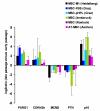How to track cellular aging of mesenchymal stromal cells?
- PMID: 20453259
- PMCID: PMC2881510
- DOI: 10.18632/aging.100136
How to track cellular aging of mesenchymal stromal cells?
Abstract
Mesenchymal stromal cells (MSC) are currently tested in a large number of clinical trials and raise high hope in regenerative medicine. These cells have to be expanded in vitro before transplantation and several studies demonstrated that long-term culture evokes continuous changes in MSC: proliferation rate decays, the cell size increases, differentiation potential is affected, chromosomal instabilities may arise and molecular changes are acquired. Long-term culture of cell preparations might also have therapeutic consequences, although this has hardly been addressed in ongoing trials so far. Reliable therapeutic regimens necessitate quality control of cellular products. This research perspective summarizes available methods to track cellular aging of MSC. We have demonstrated that gene expression changes and epigenetic modifications are continuously acquired during replicative senescence. Molecular analysis of a suitable panel of genes might provide a robust tool to assess efficiency and safety of long-term expansion.
Conflict of interest statement
The authors of this manuscript have no conflict of interest to declare.
Figures


Similar articles
-
Replicative senescence-associated gene expression changes in mesenchymal stromal cells are similar under different culture conditions.Haematologica. 2010 Jun;95(6):867-74. doi: 10.3324/haematol.2009.011692. Epub 2010 Jan 6. Haematologica. 2010. PMID: 20053868 Free PMC article.
-
Replicative senescence of mesenchymal stem cells: a continuous and organized process.PLoS One. 2008 May 21;3(5):e2213. doi: 10.1371/journal.pone.0002213. PLoS One. 2008. PMID: 18493317 Free PMC article.
-
Proof of principle: quality control of therapeutic cell preparations using senescence-associated DNA-methylation changes.BMC Res Notes. 2014 Apr 23;7:254. doi: 10.1186/1756-0500-7-254. BMC Res Notes. 2014. PMID: 24755407 Free PMC article.
-
Controversial issue: is it safe to employ mesenchymal stem cells in cell-based therapies?Exp Gerontol. 2008 Nov;43(11):1018-23. doi: 10.1016/j.exger.2008.07.004. Epub 2008 Jul 24. Exp Gerontol. 2008. PMID: 18694815 Review.
-
The Importance of Stem Cell Senescence in Regenerative Medicine.Adv Exp Med Biol. 2020;1288:87-102. doi: 10.1007/5584_2020_489. Adv Exp Med Biol. 2020. PMID: 32026416 Review.
Cited by
-
Donor age of human platelet lysate affects proliferation and differentiation of mesenchymal stem cells.PLoS One. 2012;7(5):e37839. doi: 10.1371/journal.pone.0037839. Epub 2012 May 25. PLoS One. 2012. PMID: 22662236 Free PMC article.
-
Stability of human mesenchymal stem cells during in vitro culture: considerations for cell therapy.Cell Prolif. 2013 Feb;46(1):10-22. doi: 10.1111/cpr.12002. Epub 2012 Nov 16. Cell Prolif. 2013. PMID: 23163975 Free PMC article.
-
New insights into osteoporosis: the bone-fat connection.J Intern Med. 2012 Oct;272(4):317-29. doi: 10.1111/j.1365-2796.2012.02564.x. Epub 2012 Jul 29. J Intern Med. 2012. PMID: 22702419 Free PMC article. Review.
-
Multi-Parameter Analysis of Biobanked Human Bone Marrow Stromal Cells Shows Little Influence for Donor Age and Mild Comorbidities on Phenotypic and Functional Properties.Front Immunol. 2019 Nov 8;10:2474. doi: 10.3389/fimmu.2019.02474. eCollection 2019. Front Immunol. 2019. PMID: 31781089 Free PMC article.
-
Role of mesenchymal stem cells in cell life and their signaling.World J Stem Cells. 2014 Jan 26;6(1):24-32. doi: 10.4252/wjsc.v6.i1.24. World J Stem Cells. 2014. PMID: 24567785 Free PMC article. Review.
References
-
- Dominici M, Le Blanc K, Mueller I, Slaper-Cortenbach I, Marini F, Krause D, Deans R, Keating A, Prockop D, Horwitz E. Minimal criteria for defining multipotent mesenchymal stromal cells. The International Society for Cellular Therapy position statement. Cytotherapy. 2006;8:315–317. - PubMed
-
- Sensebe L, Krampera M, Schrezenmeier H, Bourin P, Giordano R. Mesenchymal stem cells for clinical application. Vox Sang. 2010;98:93–107. - PubMed
-
- Wagner W, Ho AD. Mesenchymal stem cell preparations-comparing apples and oranges. Stem Cell Rev. 2007;3:239–248. - PubMed
Publication types
MeSH terms
LinkOut - more resources
Full Text Sources
Other Literature Sources

